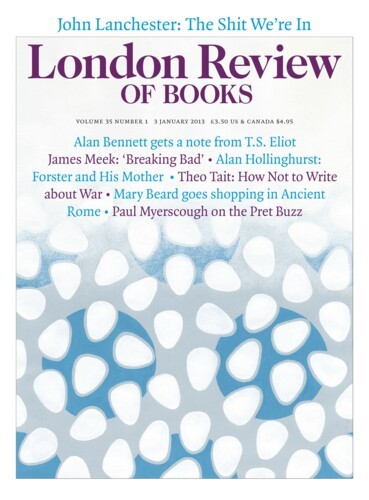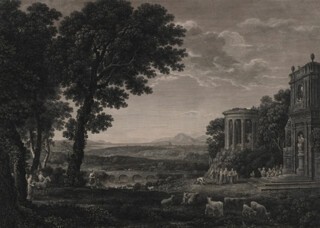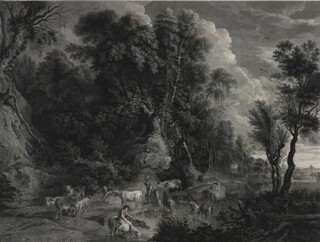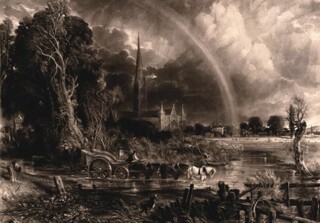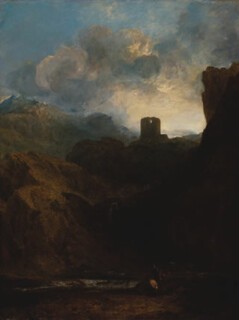Among various unforgettable moments in a life much of which has been spent thinking about landscape in literature and the visual arts was a remark made ten years ago by Kirsty Wark in the programme which follows Newsnight on Fridays, in which she was chairing a discussion of the Gainsborough exhibition then at Tate Britain. Gainsborough’s landscapes, she invited one of her panel to agree, were ‘irrelevant’. She meant, I think, that they had nothing to say to the present day, and I can’t forget her remark only because I repeat it so often to my students. Now that so many of them want to learn only about the contemporary, and many universities feel increasingly little obligation to teach them much else, the remark is useful to get them thinking about whether they might learn as much about the culture of the present day by studying what appears to be ‘irrelevant’ to it, as they can from works which claim to speak directly of the times we live in.
There is, however, nothing irrelevant about the new show at the Royal Academy, featuring Gainsborough, Constable and Turner; not because of anything it has to say about ‘the making of landscape’, but because it is so evidently a show for an Age of Austerity, a show of our favourite artists intended to raise as much money as possible for as little as possible. It’s very small, compared with the generous exhibitions of landscape painting in past decades, the exhibits are all taken entirely from the collection of the cash-strapped Academy itself, and its explanatory and interpretative resources are very thin – a little pamphlet in lieu of a catalogue, a very few interpretation boards, and a hard to find list of exhibits which I didn’t discover until I’d spent much of my time scribbling down the titles of the pictures. There was no list in my reviewer’s pack, and no one in the rooms seemed to be holding one, but outside in Piccadilly I found a copy, trodden into the pavement outside Fortnum’s, where, I have since learned, you could have a ‘Jubilee Tea in the Parlour and a Ticket to the Exhibition’ for only £23. A show, then, on a shoestring, perhaps a cheap filler in the schedule before what will no doubt be an opulent as well as mouthwatering Manet exhibition. But the Academy must do what it can to save and survive, and for most of us at the exhibition, who didn’t look as if we had had to make many sacrifices in the last few years, it is no doubt salutary to feel the pinch, and to realise we are all in it together.
The uses of adversity are sweet as well as bitter, as the old Duke in Shakespeare almost said, and what is best about Constable, Gainsborough, Turner and the Making of Landscape is probably as much a result of hard times as what is not so good. The exhibition tells two stories which never really come together, but the first, focusing on the importance of the reproductive print to the development of landscape, will be a revelation to those unfamiliar with this aspect of the genre in Britain. The story begins with a roomful of sumptuous late 17th and 18th-century prints of paintings by the Continental artists on whose work British artists began by modelling their own: chiefly Claude Lorrain, Salvator Rosa and the Poussins, Nicolas and his brother-in-law Gaspard Dughet, but including also Rubens’s hugely influential The Watering Place, here in John Browne’s engraving of 1770. Though the prints are grouped by the authors of the paintings on which they are based, the room – and Andrew Wilton’s excellent essay on this aspect of the show – invites us to focus on the printmakers, especially the French Protestant immigrant François Vivares, and the brilliant William Woollett, who became the finest, the most intricate and industrious engraver of landscape in Europe. Vivares’s work is represented here by four superb engravings after Claude, and by the intriguing sequence of prints he and others made of paintings of the Peak District by Thomas Smith of Derby, so unlike anything else in the history of landscape art that I have to slap my wrist to stop myself reaching for the word ‘surreal’. It was chiefly through the engravings of these and other printmakers that European landscapes were known to young British artists. Turner and Constable would have known even the landscapes of their great predecessor Richard Wilson mainly through some wonderful prints by Woollett and others, and at the Academy no fewer than 12 of these are exhibited together, classical landscapes animated by mythological figures, and opposite them some of the great Welsh views including Snowdon, Cader Idris and William Edwards’s great bridge over the Taff at Pontypridd.
An exhibition with a bigger budget, able to pull in loans of the great landscape painters’ greatest oils, would never have made room for so much monochrome, and would have been unable therefore to show how fascinated Constable and Turner were with the tradition of landscape engraving and with the new methods of printmaking available to artists of their generation. Constable favoured the rich chiaroscuro and dramatic tonal contrasts of mezzotint, printed in rich black, represented here by five large plates of some of his most famous later paintings by David Lucas, who, by careful obedience to the painter’s obsessive instructions, and by evident sympathy with his unorthodox way with paint, somehow seems to produce in monochrome, not an equivalent of, but an appropriate and exciting alternative to the then unusually bright palette of Constable. The prints Turner brought together in his Liber Studiorum, a kind of pictorial treatise on landscape, are fascinating for the complex mixture of methods used to reproduce the wide range of effects in his paintings and drawings. Turner himself usually etched the outlines, but lights, the darks, the textures of surfaces were rendered by other artists, usually in mezzotint, sometimes in aquatint, sometimes both together, and the plates were printed in brown ink. The contrast between the Liber and Constable’s own pictorial treatise, Various Subjects of Landscape, Characteristic of English Scenery, with mezzotints by Lucas, is extreme and tends to run counter to what, on the basis of their paintings, we might have expected. Of the two, Turner is usually cast as the more dramatic, the more directly arresting, but Lucas’s Constable is dark, brooding, melodramatic even, while the Turner of the Liber seems more inclined to repose. The wall of the gallery where Lucas and the Liber are shown side by side is a wonderful show within a show, worth visiting the gallery if to see only that.
Advance publicity invites prospective visitors to ‘fall in love all over again with three giants of British landscape painting’, and, reflecting no doubt a worry about the possible effect on the gate, it neglects to say that its chief, bold focus is on printed works. Instead the ‘highlights’ of the exhibition are described as four grand oil paintings: Gainsborough’s great confection, Romantic Landscape, of about 1783; Constable’s ‘two great landscapes of the 1820s’, The Leaping Horse and A Boat Passing a Lock, and Turner’s ‘brooding Dolbadern Castle’, of 1800. Unless my memory deceives me, these are the only large landscapes by the three giants the Academy owns, and elsewhere in the show landscapes in oils are very thin on the ground. There’s a superb one by Pier Francesco Mola of Christ in a wild woodland landscape, though its presence in the exhibition could have done with some explanation; a version of Richard Wilson’s The White Monk, attributed to his ‘circle’; and a dozen of Constable’s small plein air oil sketches on paper. It will be interesting to see whether the Big Three will still be loveable in the absence of almost all the old favourites that have made them so. The effect may be a bit like going to a concert by the Stones or the Who and being offered only stuff from their latest album.
The limitations of the Academy’s collection, including as it does the only landscapes by the Big Three that could be described in some degree as ‘sublime’, encourage if they do not determine the other main story the exhibition has to tell, a story I sincerely hope will die before I get old. It’s the one about how there was in the 18th century a variety of landscape called ‘topography’, sometimes ‘strict topography’, which was committed to ‘the accurate recording of particular places’. The exhibition includes several such pictures, watercolours by Sandby, Michael Angelo Rooker and others, beautiful but somehow small-minded, limited in their ambition, we are invited to believe. Eventually, however, in the early 19th century, topographical art was transcended by something infinitely more serious and more powerful, a sublime style of painting that sought to represent the ‘grandeur of nature’, and to produce in us ‘feelings of awe, fear or horror’. This new landscape art, exemplified primarily by Turner, could also see through mere ‘particular places’ to show us something that transcended all particularity, and which in this exhibition goes by such names as ‘British landscape scenery in its own right’, or ‘nature itself’. The explanatory pamphlet does not say what ‘British landscape scenery’ would look like when all particularity had been banished, leaving only ‘nature itself’, but I imagine that it would look like nothing at all. Perhaps Hazlitt was right when he said that Turner painted ‘pictures of nothing, and very like’.
I have all sorts of objections to this story. First of all, after spending much of the last four years comparing images of North Wales, described or dismissed as ‘topographical’, with the scenes they depict, I see no evidence that most topographical artists usually set out to give ‘accurate records’ of places. Some did, sometimes, especially when representing places and especially buildings so well known that many people would be in a position to compare the representation with the thing represented. But for many artists, especially when depicting remote and little visited locations, accuracy seems to have been a low priority, well below the desire to produce a harmonious or picturesque or dramatic composition. It is a simple misreading of Burke’s theory of the sublime to claim that paintings by Turner and others, described as ‘sublime’, evoke, or even seek to evoke, ‘feelings of awe, fear or horror’. Some of the places he painted might have done – the precipices, the towering waves, the threats of landslide or avalanche – but not the paintings themselves. I watched the reactions of visitors as they stopped in front of the sublime Dolbadern Castle. None was exhibiting outward signs of horror, and though a few might have been inwardly awed or apprehensive, they seemed able to cope, and passed on to the next exhibit cheerfully enough.
I’m happy to agree that the sublime in paintings seeks to evoke feelings different from those evoked by images described as topographical: as Burke argued, it addresses us more as isolated individuals than as social beings, and to some of us, in some moods, its address may seem more powerful, more immediate. Many supposedly topographical images however, many of them by Turner himself, whether or not they aspire to strict accuracy of representation, evoke ideas and feelings that sublime pictures do not: more social than solitary, more about the way landscapes are inhabited, shared, possessed, argued over, exploited – for better or worse, humanised. The story of the transcendent sublime seems to trivialise such notions and the feelings associated with them, and it is time for the opposite story to be told, in an exhibition of ‘topographical’ art that could be seen as a development from the wonderful and successful Paul Sandby show a couple of years ago. It could be based on the King’s Topographical Collection in the British Library, assembled on behalf of George III. It covers pretty well every county in Britain, and the images it contains – in a wide range of printing methods, often in sparkling condition, many beautifully hand-coloured, yet unknown to the wider public – are as much about the making of landscape in Britain as are the great paintings by the Big Three.
Send Letters To:
The Editor
London Review of Books,
28 Little Russell Street
London, WC1A 2HN
letters@lrb.co.uk
Please include name, address, and a telephone number.
